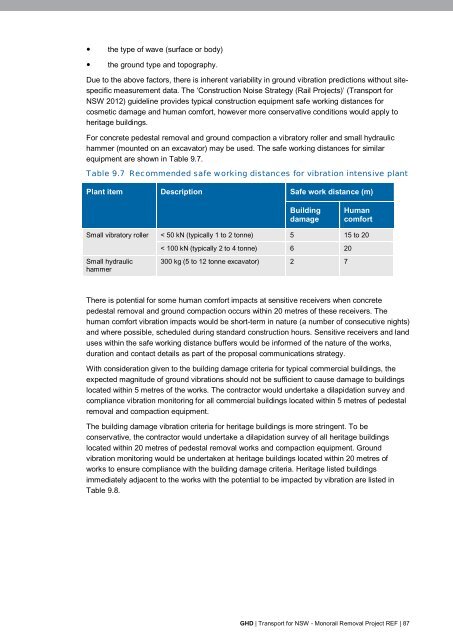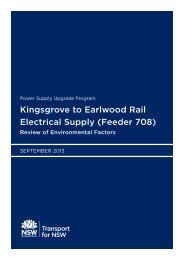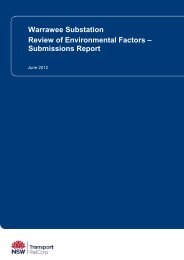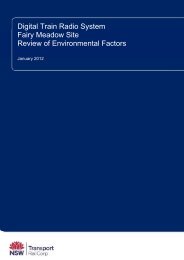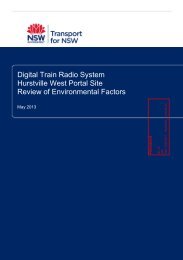Monorail Removal Project - Review of Environmental Factors (REF)
Monorail Removal Project - Review of Environmental Factors (REF)
Monorail Removal Project - Review of Environmental Factors (REF)
You also want an ePaper? Increase the reach of your titles
YUMPU automatically turns print PDFs into web optimized ePapers that Google loves.
• the type <strong>of</strong> wave (surface or body)• the ground type and topography.Due to the above factors, there is inherent variability in ground vibration predictions without sitespecificmeasurement data. The ‘Construction Noise Strategy (Rail <strong>Project</strong>s)’ (Transport forNSW 2012) guideline provides typical construction equipment safe working distances forcosmetic damage and human comfort, however more conservative conditions would apply toheritage buildings.For concrete pedestal removal and ground compaction a vibratory roller and small hydraulichammer (mounted on an excavator) may be used. The safe working distances for similarequipment are shown in Table 9.7.Table 9.7 Recommended safe working distances for vibration intensive plantPlant item Description Safe work distance (m)BuildingdamageHumancomfortSmall vibratory roller < 50 kN (typically 1 to 2 tonne) 5 15 to 20< 100 kN (typically 2 to 4 tonne) 6 20Small hydraulichammer300 kg (5 to 12 tonne excavator) 2 7There is potential for some human comfort impacts at sensitive receivers when concretepedestal removal and ground compaction occurs within 20 metres <strong>of</strong> these receivers. Thehuman comfort vibration impacts would be short-term in nature (a number <strong>of</strong> consecutive nights)and where possible, scheduled during standard construction hours. Sensitive receivers and landuses within the safe working distance buffers would be informed <strong>of</strong> the nature <strong>of</strong> the works,duration and contact details as part <strong>of</strong> the proposal communications strategy.With consideration given to the building damage criteria for typical commercial buildings, theexpected magnitude <strong>of</strong> ground vibrations should not be sufficient to cause damage to buildingslocated within 5 metres <strong>of</strong> the works. The contractor would undertake a dilapidation survey andcompliance vibration monitoring for all commercial buildings located within 5 metres <strong>of</strong> pedestalremoval and compaction equipment.The building damage vibration criteria for heritage buildings is more stringent. To beconservative, the contractor would undertake a dilapidation survey <strong>of</strong> all heritage buildingslocated within 20 metres <strong>of</strong> pedestal removal works and compaction equipment. Groundvibration monitoring would be undertaken at heritage buildings located within 20 metres <strong>of</strong>works to ensure compliance with the building damage criteria. Heritage listed buildingsimmediately adjacent to the works with the potential to be impacted by vibration are listed inTable 9.8.GHD | Transport for NSW - <strong>Monorail</strong> <strong>Removal</strong> <strong>Project</strong> <strong>REF</strong> | 87


